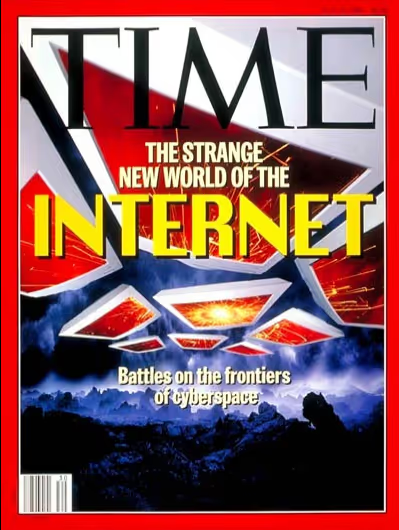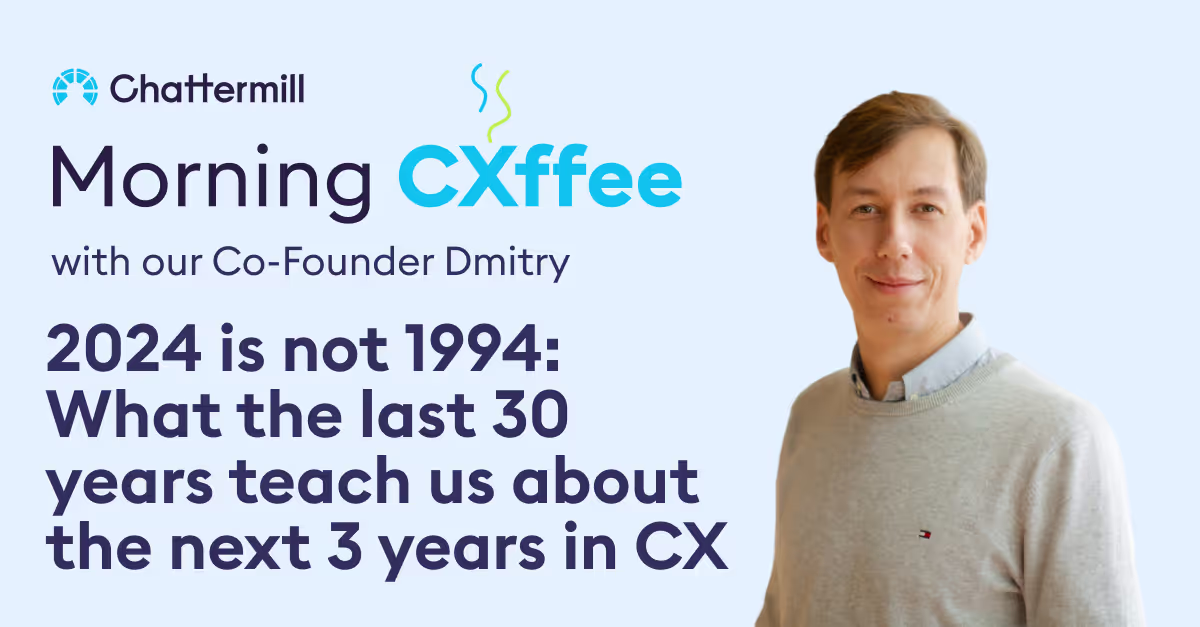It’s 1994, your Sony Walkman is rocking to the tunes of the day, Oasis have just released Definitely Maybe and Blur have put out Parklife.
Your shopping experience involves visiting your local town to see what clothes River Island and Nike have to offer.
Next up there's a visit to the CD store to check out the latest music. Green Day, REM, Pink Floyd and Madonna are all putting out new tunes and somewhere in Ireland the Cranberries are busily recording Zombie.
After that it’s over to Kodak to pick up your holiday pictures and then finally Blockbuster Video to select the latest movie to watch. Harrison Ford is the Fugitive, but Cool Runnings also catches the attention. John Candy coaching Jamaican sprinters to compete for Olympic Bobsled gold, sounds intriguing…
On the TV sporting giants grace the court, field and rink. Jordan, Sampras, Beckham and Gretzky.
Jeff Bezos quits his job at an investment bank to move to Seattle and open up a virtual book store. Myspace was still 9 years away and if you knew what the internet was you were busy annoying the rest of your household by taking your home phone line out of action.
1994 was a year where we can see the birth of key trends that have fundamentally shaped the world ever since. But what’s perhaps more interesting is how, by taking a moment to look back, we get an eerily clear view of the future.
So what do the last 30 years teach us about the next 3?
An inflection point
In 1993 CERN puts the World Wide Web software in the public domain. Tim Berners Lee’s creation is about to change the world forever.
Less than 12 months later Time Magazine runs a cover story on the ‘Strange new world of the internet’ and what you need to know about it. Early pioneer of the internet Yahoo is founded, Amazon follows. Microsoft launches their first website.

In the same year IBM launch the first ever touchscreen smartphone, the Simon Personal computer. It has the ability to receive both emails and faxes.
The combination of these two developments, changes the way we live our lives.
It’s a change that has seismic consequences. From a business point of view it fundamentally redefines the rules of the game. What a company needs to be successful will never be the same again. A brief look at the top of the stock market illustrates the monumental change that is to follow.
In 1994 the top 5 biggest companies are Exxon, Coca-Cola, Walmart, Raytheon and Merck; organisations working in Oil, FMCG, Grocery, Defence, and Pharmaceuticals.

In 2024 they are Apple, Microsoft, Alphabet, Amazon and Nvidia.

Alphabet and Amazon didn’t even exist on the 1st January 1994 and Nvidia was less than a year old. 30 years later not a single one of the 1994 top 5 is even in the top 10.
The implications are game changing
These developments set off a chain reaction.
Back in the 1990s if you were unhappy with the service a company provided you could switch to someone else. Unfortunately the alternative option would be more or less the same. All banks had terrible customer service, you had to wait on hold forever to speak to any of the energy companies. Any slight benefit of switching would be offset by the inconvenience of the process, paperwork and learning a new format. All things considered, staying put was probably the least painful experience.
Suddenly the internet makes it possible for people to start companies more easily than ever before, people in garages and bedrooms have the opportunity to start businesses and reach millions of people.
They can’t compete with the established players in terms of brand recognition, marketing budget or advertising spend so they focus on customer pains and work to solve these problems more effectively. They know there is both risk and effort for a customer to switch to something new, so they have to make their solution not just slightly better but significantly better.
Fortunately they are starting from scratch so they can choose which pain they want to solve and which customers they want. They target the profitable parts of established businesses, carving off a particular product offering or customer segment. Undistracted by meeting the needs of a legacy customer base they ruthlessly focus on effectively meeting the needs of the customers they are targeting.
Customers have another option.
Social media and online reviews fuel the revolution
Back in the 90s, other customers would never hear about the problems you experienced with a brand. If you were unhappy with a company you phoned them, waited on hold and they didn’t have to do anything. Only your immediate network might hear of your dissatisfaction.
The companies controlled the narrative. Advertising reaching millions drowned out the customer disatisfaction. The only public platforms for customer complaints were weekly television programs that looked into the very worst excesses of corporate irresponsibility.
Social media suddenly provided a public platform for poor experiences. It also forced organisations to respond publicly. Bad experiences became much more visible and potential customers could assess a business’ willingness to fix their mistakes before they took the decision on whether to use them. Simultaneously online reviews created a lasting record of a product or service written by customers themselves.
Word of mouth was no longer constrained to networks of friends, it was global.
Switching for a better experience becomes easy
Greater choice and awareness mean customers do start to transition to new options but effort is required to make the change, it is still often easier to simply stay with an existing company.
In 2008 the internet and the smartphone combine again to give the world ‘the app’. The App store launches with 500 apps. Less than 10 years later there are 2.2million.
It becomes incredibly easy to switch. Downloading a new app can be done anywhere anytime. A customer standing in the rain feeling the pain of being unable to find a taxi can download an app to solve the problem instantly and have an Uber booked 5 mins later.
Switching used to be time consuming, suddenly it is possible to create an account and switch in seconds. If one food delivery app doesn’t have a restaurant you like, it’s no effort to simply open an account with another. If Deliveroo delivers poor service the customer can simply switch to UberEats. The only effort involved is sliding their thumb 1cm to the left on their smartphone screen.
Customers now have choice and it is easy to switch. The idea of switching to get a better experience is not new, as humans we have always selected where to spend time and money based on the experience. Apps, smartphones and competition just gave us the tools to do it more effectively. We always had the power to vote with our feet, but now we can vote with our thumbs. It’s a heck of a lot more convenient.
The upshot for new players and incumbents alike is that working to keep customers has just got a whole lot more urgent. The importance of customer retention in this new, low friction world starts to become clear.
The point of no return
It’s impossible to say exactly where, but a tipping point is reached. As Amazon and others spread into more areas with their obsessive focus on customer experience, they change the rules of the game for everyone.
“If I can get a wardrobe delivered the next day and I can return it for 30 days for free, why can’t I do that with everything I buy?”
In response to this new environment customer expectations fundamentally change. What is considered an acceptable experience is now being constantly reset to ever higher levels.
From this point on it’s a race. But one that not all organisations have figured out how to win.
The dawn of quantifying the experience
As the change in customer behaviour and expectations is recognised the importance of the customer’s experience in this new world becomes clear.
Incumbent companies slowly start to recognise things have changed. While organisations that were once disruptors now have competition, as new challengers join the market looking to go after the huge pool of customers that they have built.
The competition intensifies and people are looking for an edge.
Books are written and new technology is created to help businesses. As transactions are increasingly carried out online more and more data is captured. It’s possible to track what customers do and where they get stuck.
Gathering feedback on products and services at scale becomes cheap and efficient. Customer insight is no longer the domain of large organisations with huge market research budgets. There is more data than ever before.
The goal is obvious, creating an experience that harnesses word of mouth acquisition and drives Customer retention is the way to succeed. The importance of focusing on the experience of the customer has become clear, but it is not easy to do.
Organisations wrestle with it, some more successfully than others...
2024 begins
So what can we take from how we got here?
The importance of experience is not some business buzzword that will be here today and superseded with something else tomorrow, it is a reflection of how we now live our lives. Any doubts, we can just take a look at our own behaviour, the apps we have and why.
Customers changing their behaviour based on their experience isn’t a fad or a trend that’s going to go away, because it’s not a new thing, it’s as old as humanity.
Taking decisions based on the experience we have had, or expect to have, is the very essence of being human.
Experience is how we learn, it is how we choose between competing options and make sense of complexity.
Communicating and sharing these experiences and the knowledge we have gained from them is an intrinsic part of our social interactions.
What has changed is the environment around us.
The opportunity that focusing on experience presents
1994 was a moment in history from which many things can trace their origins, it’s easy to think “Wow it would have been amazing to know what we know now back then. Think of the success we could have had!”
With hindsight it is clear to see that 1994 was a year when multiple trends and developments started to form into an opportunity. Yet some people recognised the moment in real time. They saw the coming together of the different strands, the combination of human tendencies, market conditions and technological possibilities and they acted.
In 2024 we stand at an equally pivotal moment in corporate history. A brief window in time where the past illuminates the future but that future has not yet arrived.
There will be winners and losers. Looking back we can see this and the game will be played out on fast forward from here on in.
What the last 30 years tells us is that experience is crucial not because someone said so, but because the world has changed.
Focusing on the experience for profitable growth remains a competitive advantage.
How long will the window of opportunity remain open? At what point will the organisations that don’t get it right cease to exist? As this 1999 interview with Jeff Bezoz demonstrates, some noticeably successful people have been aware of this for a while. The signs are now clear, soon everyone will see the future; it will be the present.
















